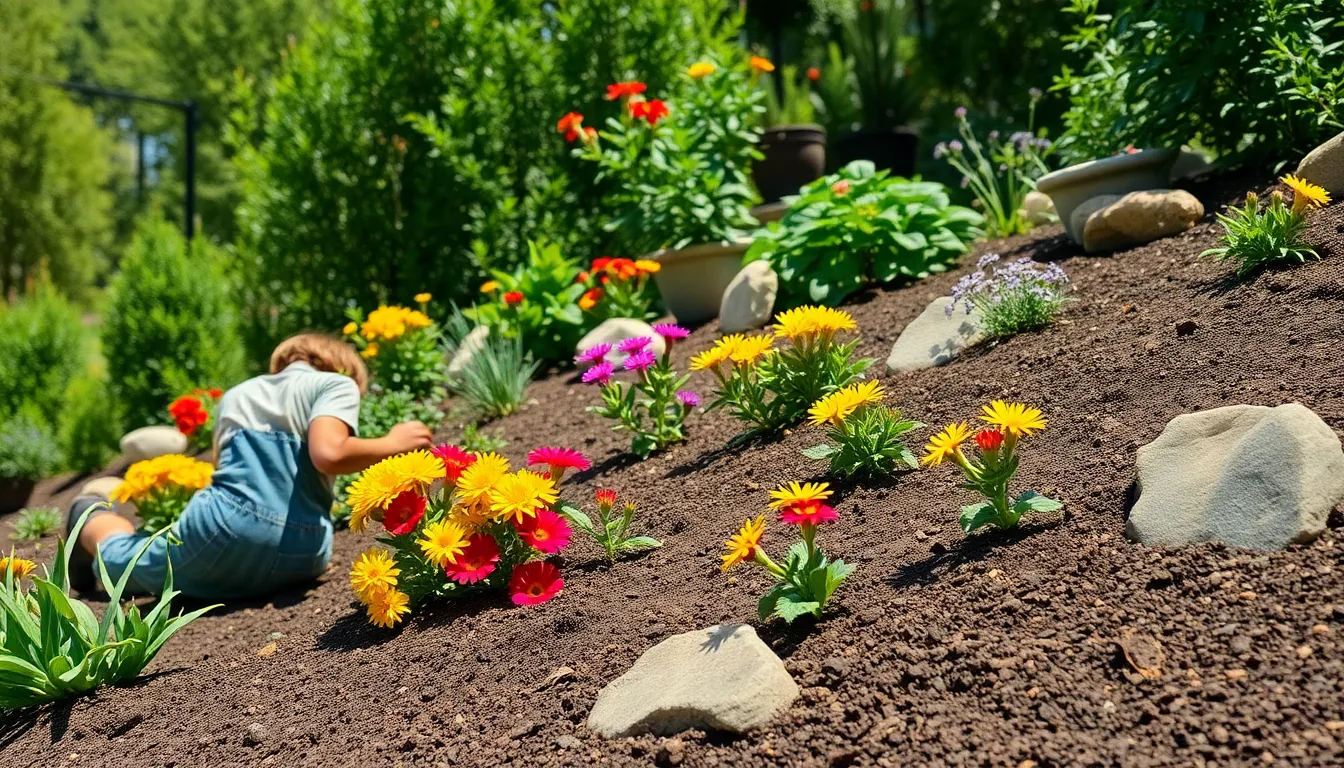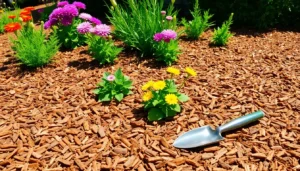When it comes to landscaping, sloped yards often get a bad rap. They’re like the awkward middle child of the garden family—overlooked and misunderstood. But fear not! Slope landscaping can transform those tricky terrains into stunning outdoor masterpieces that even your flat-ground friends will envy.
Table of Contents
ToggleWhat Is Slope Landscaping?
Slope landscaping involves designing and modifying sloped or hilly terrains to enhance their aesthetic and functional qualities. This approach utilizes the natural contours of the land, turning challenges into opportunities for creativity.
Techniques such as terracing, where flat areas are created on slopes, allow for more effective planting and easier maintenance. Retaining walls often provide necessary support for soil and plants, preventing erosion while adding visual interest. Various plants, including ground covers and native flora, thrive in these conditions, requiring less water and maintenance.
Incorporating features like steps, pathways, or decorative stones can enhance accessibility and create focal points. Water management plays a crucial role—strategies like rain gardens can capture runoff, promoting drainage while enriching the landscape.
Landscapers often choose diverse plantings to improve biodiversity, which can attract beneficial wildlife. Seasonal interest can be created by selecting plants that bloom at different times, extending the visual appeal throughout the year.
Challenges aren’t insurmountable; methods such as soil amendment can improve growth potential on slopes. Structural adjustments might be necessary for steep terrains, promoting stability while preventing erosion. Educational resources can help homeowners understand their specific landscape needs, maximizing the effectiveness of their slope landscaping projects.
Ultimately, slope landscaping transforms typically overlooked areas into visually stunning, functional spaces. By fully exploiting the terrain’s potential, homeowners can create inviting, vibrant outdoor environments.
Benefits of Slope Landscaping

Slope landscaping transforms yards into functional and attractive spaces. It offers several benefits that enhance both the visual appeal and the practicality of sloped terrains.
Enhanced Aesthetic Appeal
Beautifully designed slopes create visual interest in any landscape. Vibrant plantings add color and texture, attracting attention and admiration. Varied elevations allow for unique design elements, such as terraces and steps, which bring depth to the environment. Implementing pathways and decorative stones creates focal points, guiding visitors through the space. These features not only please the eye but also establish inviting areas for relaxation and gatherings.
Improved Erosion Control
Effective erosion control is a vital advantage of slope landscaping. Retaining walls and terracing minimize soil movement, providing stability to the landscape. This approach prevents loss of valuable topsoil and protects against flooding during heavy rains. Additionally, deep-rooted plants anchor the soil, reducing runoff and promoting water retention. Implementing rain gardens captures excess water, further enhancing drainage. These methods work together to maintain a durable and sustainable landscape over time, allowing homeowners to enjoy their sloped yards without concern.
Key Techniques for Slope Landscaping
Effective slope landscaping requires specific techniques to optimize the terrain’s potential. Techniques such as terracing, retaining walls, and native plant selection enhance both aesthetics and functionality.
Terracing
Terracing organizes sloped areas into distinct, level surfaces. These flat sections facilitate planting and maintenance. Gardeners can create multiple planting zones with different microclimates. Vegetables, flowers, or ornamental plants flourish in this setup. Drainage can be better managed through these terraces, reducing erosion risks as well. This method also encourages effective soil usage, promoting healthier root development.
Retaining Walls
Retaining walls provide essential support for sloped landscapes. They hold back soil, preventing erosion and land movement. By using various materials like stone, wood, or concrete, visual interest is added along with structural integrity. Functions of retaining walls extend beyond aesthetics; they can also create additional planting space or seating areas. Proper drainage systems integrated into retaining walls prevent water buildup, ensuring stability and long-term effectiveness.
Native Plant Selection
Native plant selection reduces maintenance requirements and enhances the local ecosystem. Plants adapted to the regional climate thrive with minimal intervention. These plants support local wildlife, such as pollinators, contributing to the area’s biodiversity. Choosing deep-rooted natives helps prevent erosion and stabilizes the soil. Additionally, a diverse array of native species creates vibrant, year-round interest in the landscape. Utilizing these plants ensures a sustainable and resilient garden that takes full advantage of the slope.
Best Plants for Slope Landscaping
Slope landscaping benefits from plants that thrive in challenging conditions. Selecting the right species enhances aesthetic appeal and promotes soil stability.
Drought-Resistant Options
Drought-resistant plants withstand low water availability, making them ideal for sloped areas. Some options include succulents, which come in various shapes and colors, creating visual interest. Lavender thrives even in dry soil and emits a pleasant fragrance. Additionally, ornamental grasses, like blue fescue, add texture and movement to the landscape. Rockrose serves as another excellent choice, producing vibrant blooms that attract pollinators. These plants require minimal maintenance, allowing homeowners to enjoy their landscapes without excessive upkeep.
Ground Covers
Ground covers play a crucial role in preventing erosion on slopes. Creeping thyme spreads quickly, forming a dense mat that stabilizes the soil. Sedum, often used for its hardiness, offers a range of colors and requires little water. Ajuga, or bugleweed, showcases beautiful foliage and flowers while providing excellent ground coverage. Furthermore, vinca minor grows vigorously, creating a lush green carpet that suppresses weeds. These ground covers reinforce soil structure, enhance biodiversity, and beautify sloped gardens effectively.
Common Challenges in Slope Landscaping
Slope landscaping presents unique challenges that can complicate design and maintenance. Addressing these issues effectively ensures a successful and sustainable landscape.
Water Drainage Issues
Water drainage poses significant challenges in slope landscaping. Rainwater tends to flow downhill, often leading to erosion and washouts. Effective drainage systems prevent soil displacement and facilitate water absorption. Strategies like installing French drains and creating swales effectively redirect excess water. Incorporating native plants with deep root systems enhances soil stabilization and slows down water runoff. Regular inspections can identify drainage issues early, allowing for prompt adjustments.
Maintenance Requirements
Maintaining sloped landscapes requires ongoing attention and effort. Areas with turf or ornamental plants often demand more frequent irrigation and weeding than flatter gardens. Implementing ground covers can significantly reduce maintenance, as they require less upkeep and discourage weeds. Mulching around plants minimizes moisture loss and controls temperature. Pruning and seasonal cleanup should remain part of the routine to keep slopes manageable and visually appealing. Planning for easy access to all areas simplifies maintenance tasks, ensuring the landscape remains attractive and healthy.
Embracing slope landscaping opens up a world of possibilities for transforming challenging terrains into captivating outdoor spaces. With the right techniques and plant selections, homeowners can create stunning landscapes that not only enhance visual appeal but also promote ecological health.
By utilizing methods like terracing and incorporating native plants, it’s possible to manage erosion while fostering a vibrant ecosystem. The careful design of pathways and drainage solutions ensures both functionality and beauty.
Ultimately, slope landscaping proves that even the most daunting yards can become inviting retreats that reflect personal style and environmental stewardship. It’s time to see sloped areas as opportunities for creativity and sustainability.







